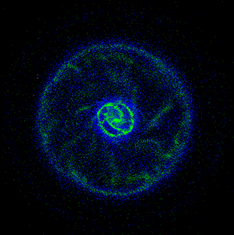


Objective: To write parallel computer codes that use tree algorithms combined with the Smooth Particle Hydrodynamics (SPH) algorithm and port to as many machines as possible.
Approach: Develop parallel codes from 'scratch' rather than porting existing serial codes so that parallelism inherent in the techniques can be more easily exploited.
Accomplishments: A code capable of simulating a large number of gravitationally interacting particles using a tree algorithm as well as a gaseous component using the SPH algorithm has been developed using the MasPar MP-2 at Goddard Space Flight Center (GSFC). This code reaches performance levels of roughly 1 GFLOPS on 16,384 processors of this machine. This code also has been ported to the Convex Exemplar SPP parallel computer at GSFC. Here, the code exceeds 1 GFLOPS on 15 processors. Message passing versions of the tree algorithm have also been developed but do not yet incorporate the SPH algorithm (CRAY T3D, Intel Paragon, Beowulf, and distributed Silicon Graphics workstations).


Significance: The tree algorithm plus SPH algorithm is used widely within astrophysics. For the simulation of many phenomena we require orders of magnitude more particles than is currently possible with serial machines, hence parallel implementations of these algorithms are desirable. The above-described codes are among the first implementations of these algorithms for some of these machines. Furthermore, these codes are made publicly available.
Status/Plans: The codes currently are being used for a variety of projects, such as the simulation of the breakup and dynamical evolution of Comet S/L 9, interactions of disk galaxies, and tests of alternative theories of gravity. Collaborations with researchers at the National Institutes of Health to consider the use of this code for the calculation of electric fields within bio-molecules have also been established. Use of this code for the simulation of the velocity fields surrounding and within clusters of galaxies is also being considered. Arrangements are being made to test and run the code on larger versions of the Convex Exemplar SPP.
Figures Caption: These figures show the results of a simulation of a disk galaxy containing a gaseous component (green particles) as well as a stellar component (blue particles). The first frame shows the galaxy before it has interacted with a companion galaxy (not shown), and the second shows the galaxy after this companion has passed through its center. This simulation was done using the tree plus SPH code running on the MasPar MP-2 at GSFC. An image of a real galaxy of this type taken by the Hubble Space Telescope is available on the World Wide Web.
Point of Contact:
Kevin Olson
George Mason University
olson@jeans.gsfc.nasa.gov
301-286-8707